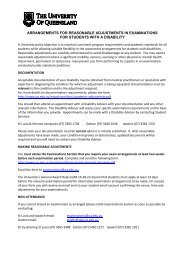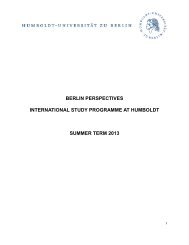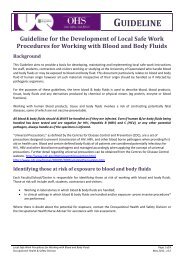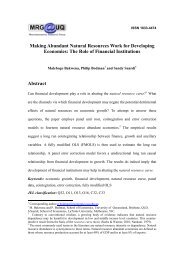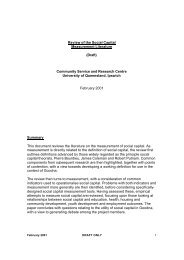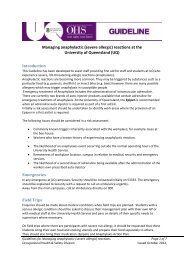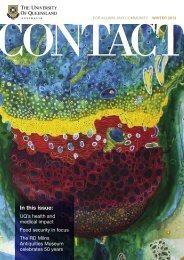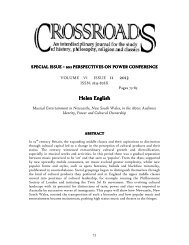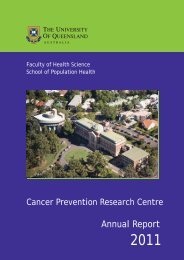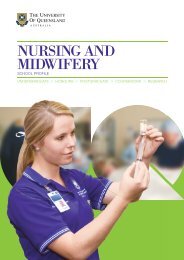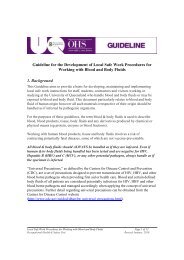Mechanical disruption of seagrass in the digestive tract of the dugong
Mechanical disruption of seagrass in the digestive tract of the dugong
Mechanical disruption of seagrass in the digestive tract of the dugong
You also want an ePaper? Increase the reach of your titles
YUMPU automatically turns print PDFs into web optimized ePapers that Google loves.
<strong>Mechanical</strong> <strong>disruption</strong> <strong>of</strong> <strong>seagrass</strong> by <strong>the</strong> <strong>dugong</strong><br />
J. M. Lanyon and G. D. Sanson<br />
Fur<strong>the</strong>r, Z. capricorni along with C. serrulata has fibre<br />
bundles associated with <strong>the</strong> vascular bundles (Kuo, 1983).<br />
Accord<strong>in</strong>g to Lees et al. (1982), a venation pattern with<br />
numerous secondary ve<strong>in</strong>s such as is found <strong>in</strong> Z. capricorni<br />
is likely to be more resistant to structural damage than o<strong>the</strong>r<br />
arrangements because secondary ve<strong>in</strong>s add structural<br />
strength. This type <strong>of</strong> venation may also be more effective<br />
<strong>in</strong> restrict<strong>in</strong>g digestion by gut microorganisms, while plants<br />
with a sparse network <strong>of</strong> secondary ve<strong>in</strong>s (Lees et al., 1982)<br />
such as Halophila ovalis will be easier to fracture.<br />
Factors o<strong>the</strong>r than leaf fibre may also affect breakability.<br />
Halophila ovalis has higher water content as a percentage <strong>of</strong><br />
total weight than Z. capricorni (Lanyon, 1991), it lacks leaf<br />
sheaths which represent a highly fibrous plant fraction, its<br />
fibre is largely non-lignified (Lanyon, 1991), and its rhizomes<br />
have cell walls that consist <strong>of</strong> non-cellulosic polysaccharides<br />
(Baydoun & Brett, 1985). Halophila ovalis<br />
appears to more readily break down under mechanical<br />
pressure than Z. capricorni. We predict that <strong>the</strong> fibre <strong>of</strong><br />
Halophila ovalis may also be more digestible because reduc<strong>in</strong>g<br />
particle size <strong>in</strong>creases fibre digestibility (McLeod &<br />
M<strong>in</strong>son, 1969). In <strong>dugong</strong> faecal samples, identifiable fragments<br />
<strong>of</strong> Z. capricorni sometimes rema<strong>in</strong>, while o<strong>the</strong>r<br />
<strong>seagrass</strong> species are <strong>in</strong>dist<strong>in</strong>guishable. In fact, most <strong>dugong</strong><br />
faeces are uniformly powder f<strong>in</strong>e with only fibrous vascular<br />
strands and no discernible tissue.<br />
<strong>Mechanical</strong> process<strong>in</strong>g <strong>of</strong> <strong>seagrass</strong><br />
Little is known <strong>of</strong> <strong>the</strong> mechanism <strong>of</strong> <strong>seagrass</strong> <strong>in</strong>gestion,<br />
ma<strong>in</strong>ly through <strong>the</strong> difficulty <strong>of</strong> observ<strong>in</strong>g <strong>dugong</strong>s <strong>in</strong> <strong>the</strong><br />
wild. However, observations suggest that unlike most herbivorous<br />
mammals, <strong>dugong</strong>s do not chew <strong>the</strong>ir food (Lanyon,<br />
1991). When feed<strong>in</strong>g on morphologically small <strong>seagrass</strong>es<br />
such as <strong>the</strong>ir preferred genera Halophila and Halodule,<br />
<strong>dugong</strong>s uproot <strong>the</strong> entire plant, creat<strong>in</strong>g feed<strong>in</strong>g trails<br />
through <strong>the</strong> substrate, with each feed<strong>in</strong>g trail represent<strong>in</strong>g a<br />
s<strong>in</strong>gle feed<strong>in</strong>g bout. Feed<strong>in</strong>g trails range <strong>in</strong> length from 1 to<br />
14 m (He<strong>in</strong>sohn & Marsh, 1977; Anderson & Birtles, 1978)<br />
and are generally between 10 and 20 cm wide (J. M. Lanyon,<br />
pers. obs.). Dugongs remove an average <strong>of</strong> 63% <strong>of</strong> <strong>seagrass</strong><br />
from trails (Wake, 1975; Preen, 1993), <strong>the</strong> equivalent <strong>of</strong><br />
about 1 m 2 <strong>of</strong> <strong>seagrass</strong> from a conservatively sized trail,<br />
with<strong>in</strong> a feed<strong>in</strong>g dive <strong>of</strong> c. 1 m<strong>in</strong> (Anderson & Birtles, 1978;<br />
Lanyon, 1991; Chivers et al., 2004). Thus, <strong>dugong</strong>s are<br />
capable <strong>of</strong> uproot<strong>in</strong>g vast quantities <strong>of</strong> <strong>seagrass</strong> <strong>in</strong> a short<br />
period, and cover<strong>in</strong>g some distance at <strong>the</strong> same time. They<br />
do not rema<strong>in</strong> on <strong>the</strong> surface, chew<strong>in</strong>g, between successive<br />
feed<strong>in</strong>g dives. In fact, <strong>the</strong> small gape and oral cavity <strong>of</strong> <strong>the</strong><br />
<strong>dugong</strong> and <strong>the</strong> lack <strong>of</strong> cheek pouches suggest that <strong>the</strong>y do<br />
not even have <strong>the</strong> capacity to reta<strong>in</strong> food for chew<strong>in</strong>g. Nor is<br />
<strong>the</strong>re evidence that <strong>the</strong>y regurgitate <strong>the</strong>ir food to re-chew <strong>in</strong><br />
a manner similar to rum<strong>in</strong>ants. Any mechanical process<strong>in</strong>g<br />
by <strong>the</strong> mouthparts occurs cont<strong>in</strong>uously as <strong>the</strong> food is<br />
<strong>in</strong>gested.<br />
The <strong>dugong</strong> is a comb<strong>in</strong>ation <strong>of</strong> a bottom feeder, a<br />
relatively poor diver and a herbivore feed<strong>in</strong>g on low nutrient<br />
food so that a large amount <strong>of</strong> food must be processed to<br />
satisfy energetic requirements. It is quite likely that for <strong>the</strong><br />
<strong>dugong</strong>, feed<strong>in</strong>g is a pro<strong>tract</strong>ed activity as it is with o<strong>the</strong>r<br />
graz<strong>in</strong>g herbivores. On <strong>the</strong> basis <strong>of</strong> <strong>the</strong>se considerations, we<br />
suggest that <strong>the</strong> masticatory apparatus <strong>of</strong> <strong>the</strong> <strong>dugong</strong> has<br />
developed to match a need for cont<strong>in</strong>uous cropp<strong>in</strong>g and<br />
process<strong>in</strong>g which mitigates aga<strong>in</strong>st chew<strong>in</strong>g, so that <strong>the</strong><br />
entire mouth cavity has been modified <strong>in</strong>to a cont<strong>in</strong>uous<br />
masticatory organ. The cont<strong>in</strong>ual forward movement <strong>of</strong> <strong>the</strong><br />
<strong>dugong</strong> while feed<strong>in</strong>g facilitates movement <strong>of</strong> <strong>seagrass</strong> <strong>in</strong>to<br />
<strong>the</strong> mouth. Initially, anterior and orthal movement <strong>of</strong> <strong>the</strong><br />
mandible (Lanyon & Sanson, 2006) secures <strong>seagrass</strong> between<br />
<strong>the</strong> pads. The backwardly directed bristles on <strong>the</strong><br />
lower horny pad comb<strong>in</strong>ed with mandibular re<strong>tract</strong>ion and<br />
orthal movement would move <strong>seagrass</strong> backwards <strong>in</strong> <strong>the</strong><br />
mouth. The oppos<strong>in</strong>g pads are probably multifunctional so<br />
that not only do <strong>the</strong>y move food up from <strong>the</strong> ventral mouth<br />
and back over <strong>the</strong> symphysial part <strong>of</strong> <strong>the</strong> mandible, but also<br />
food is masticated on <strong>the</strong> way by <strong>the</strong> cornified papillae and<br />
bristles on <strong>the</strong> pads and palate (Lanyon & Sanson, 2006),<br />
ra<strong>the</strong>r like a conveyer belt.<br />
However, this system can only work if <strong>the</strong> fracture<br />
properties <strong>of</strong> <strong>the</strong> diet are such that hard enamelled organs<br />
are not required. As described <strong>in</strong> this study, this is a peculiar<br />
property <strong>of</strong> low fibre <strong>seagrass</strong>es. It is <strong>in</strong>terest<strong>in</strong>g that o<strong>the</strong>r<br />
animals which utilize a <strong>seagrass</strong> food source can effectively<br />
macerate <strong>the</strong> diet without teeth: for example waterfowl<br />
(Thayer et al., 1984), which have a muscular gizzard; fish<br />
(Pollard, 1984), which have gill rakers, and <strong>the</strong> green turtle<br />
Chelonia mydas (Bjorndal, 1979, 1980). Each <strong>of</strong> <strong>the</strong>se<br />
animals has a ‘beak’ with which to <strong>in</strong>gest <strong>seagrass</strong> but no<br />
tooth surfaces, and like o<strong>the</strong>r lower vertebrates lack a jaw<br />
system capable <strong>of</strong> translational mastication. However, despite<br />
<strong>the</strong> lack <strong>of</strong> teeth <strong>in</strong> <strong>the</strong> green turtle and <strong>the</strong> fact that it<br />
does not masticate its food (Bjorndal, Bolten & Moore,<br />
1990), <strong>the</strong> stomach contents are well macerated. Thus,<br />
breakdown <strong>of</strong> <strong>the</strong> food must occur with<strong>in</strong> <strong>the</strong> s<strong>of</strong>t parts <strong>of</strong><br />
<strong>the</strong> <strong>digestive</strong> <strong>tract</strong>. In <strong>the</strong> green turtle, <strong>the</strong>re are cornified<br />
papillae <strong>in</strong> <strong>the</strong> oesophagus whose function rema<strong>in</strong>s largely<br />
unknown, but it has been suggested that <strong>the</strong>y may aid <strong>in</strong><br />
crush<strong>in</strong>g <strong>the</strong> food (Skoczylas, 1978). In fish, <strong>seagrass</strong> is<br />
macerated <strong>in</strong> <strong>the</strong> mouth, pharynx and stomach (Ogden,<br />
1980). Similarly <strong>in</strong> <strong>the</strong> <strong>dugong</strong>, apart from <strong>the</strong> oral cavity,<br />
breakdown could presumably occur <strong>in</strong> <strong>the</strong> muscular oesophagus<br />
(Owen, 1838) and <strong>in</strong> <strong>the</strong> thick-walled (Osman Hill,<br />
1945) and muscular small <strong>in</strong>test<strong>in</strong>e (Owen, 1838) and stomach.<br />
In fact, <strong>the</strong> process <strong>of</strong> detrition or wear<strong>in</strong>g away <strong>of</strong><br />
<strong>the</strong> <strong>in</strong>gesta appears to account for a substantial proportion<br />
<strong>of</strong> <strong>the</strong> physical particle reduction dur<strong>in</strong>g <strong>the</strong> <strong>digestive</strong><br />
process <strong>of</strong> <strong>the</strong> <strong>dugong</strong>. Breakdown <strong>of</strong> <strong>seagrass</strong> dur<strong>in</strong>g<br />
passage through <strong>the</strong> mouthparts and <strong>digestive</strong> <strong>tract</strong> appears<br />
to be facilitated by low fibre levels.<br />
The <strong>dugong</strong> does not fit <strong>the</strong> generally accepted paradigm<br />
<strong>of</strong> a mammalian h<strong>in</strong>dgut fermenter <strong>in</strong> terms <strong>of</strong> development<br />
<strong>of</strong> dentition. In fact, <strong>the</strong> <strong>dugong</strong> appears to have abandoned<br />
a presumably ancestrally efficient dentition <strong>in</strong> favour <strong>of</strong><br />
development <strong>of</strong> s<strong>of</strong>t mouthparts, which may be better<br />
adapted for deal<strong>in</strong>g with a <strong>seagrass</strong> diet that is low <strong>in</strong> fibre.<br />
However, great development <strong>of</strong> <strong>the</strong> horny pads and <strong>the</strong><br />
286<br />
Journal <strong>of</strong> Zoology 270 (2006) 277–289 c 2006 The Authors. Journal compilation c 2006 The Zoological Society <strong>of</strong> London


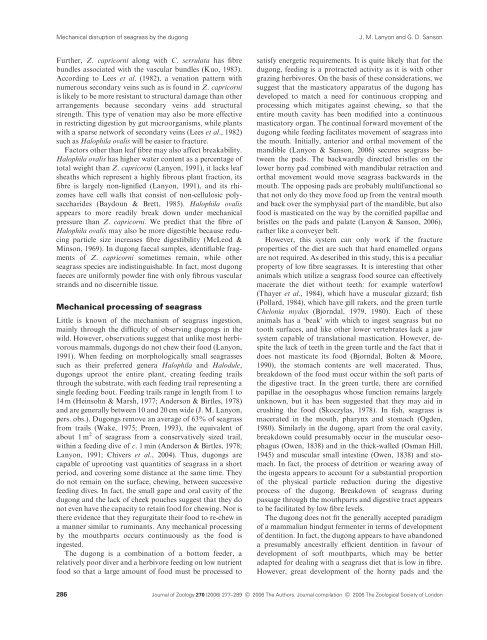

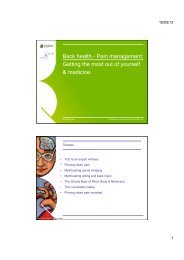
![Recycling [ PDF, 62KB ] - University of Queensland](https://img.yumpu.com/51805185/1/184x260/recycling-pdf-62kb-university-of-queensland.jpg?quality=85)
